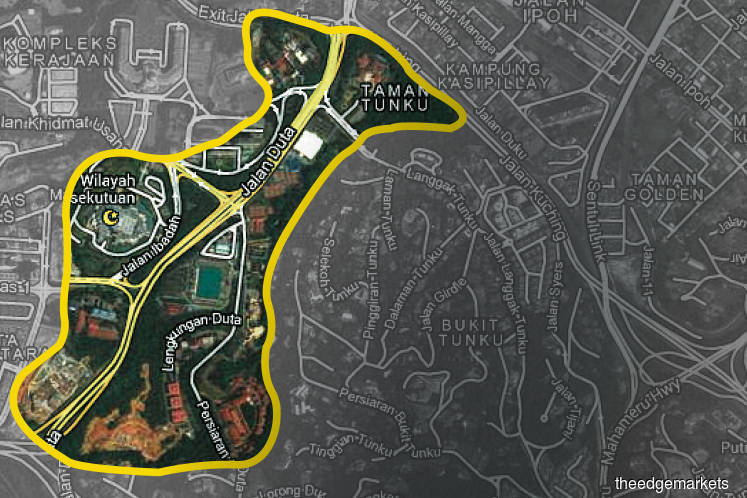
KUALA LUMPUR (Sept 20): In one of the longest-standing land disputes involving the federal government, a senior federal counsel explained to the High Court why the government’s valuation of mesne profit over the Semantan Estate (1952) Sdn Bhd’s acquisition of 263.272 acre land in Mukim Batu, now known as the Duta enclave or Jalan Duta, is a mere fraction of one a valuer appointed by the plaintiff had derived.
Senior federal counsel Mohammad Al Saifi Hashim said the government’s valuation showed that the compensation recommended for the land acquired 66 years ago is RM289.846 million, compared to the maximum RM13.242 billion valuation that includes compound interests by Semantan Estate’s appointed valuer Foo Gee Jen.
Foo had earlier testified for Semantan Estate that his estimation of mesne profit without interest to be about RM3.1 billion for the period, but could run up to RM6.646 billion with simple interest, and RM13.242 billion with compound interest.
Al Saifi said the difference was despite both Foo — who is the chairman of CBRE|WTW — and the government valuers from the Valuation and Property Services Department from Ministry of Finance adopting the same valuation method, namely the “decapitalisation of market value”.
Mesne profits are “the rents and profits which a trespasser has, or might have, received or made during his occupation of the premises, and which therefore he must pay to the true owner as compensation for the tort which he has committed”, according to Jowitt’s Dictionary of English Law.
Seven reasons of lower estimation
The senior federal counsel, in his opening defence statement before the High Court on Wednesday, gave seven reasons for the differing figures, namely:-
- The mesne profits is supposed to be assessed based on market rental of vacant land only. However, Semantan Estate's valuer has included the rental of government buildings when factoring in simple interests and compound interests while calculating the compensation.
- The difference of base value in year 1956/1957, whereby the fair value of the subject land was assessed at RM3,764 per acre by the government while the company’s valuer estimated it to be RM6,000 per acre.
- The zoning details gazetted by Kuala Lumpur City Hall was not properly taken into consideration by Semantan Estate's valuer. Instead of referring to the zoning of the land based on the local plan enforced, it arbitrarily assessed the potential of the land base on surrounding development;
- The comparable evidence adopted by the private valuer were allegedly not suitable and improper, with some evidence’s source not found in the record the government’s valuer;
- The value movement set by the company’s valuer for the period of 66 years was unreasonably high and not in line with the economic conditions;
- The rate of return of the land determined by the company’s valuer was allegedly totally inaccurate, resulting in the rental used to derive the compensation being way too high. This is due to its valuer benchmarking the rate of return against double-storey houses as opposed to the original status of vacant land; and
- The company’s valuer also factored in simple and compounding interest in their valuation. However, simple and compounding interest is not allowable under the law.
Al Saifi described the case as the longest legal land dispute matter considering its large acreage and covers among others the Federal Territory mosque, the National Archives, the Federal Territories Syariah Court and the Tun Razak hockey stadium.
“The potential compensation amount will certainly be a financial burden to the Malaysian government and our country," he said.
History of the case
The long-standing dispute concerns the 263.72 acres (106.72 hectares) land owned by Semantan Estate which was acquired in 1956 for RM1.32 million to be slated as the Duta enclave.
In 2009, the High Court ruled that the government had wrongly acquired the land and further ruled that it had trespassed on the land. The decision was affirmed by the Court of Appeal in May 2012 and the Federal Court upheld the courts’ decision ruling that the government had wrongly acquired the land.
The government tried to review the Federal Court’s decision in 2012, but the apex court dismissed its application in November 2018.
As a result of the decision, the High Court was ordered to estimate the mesne profits that is to be paid out to Semantan resulting in this ongoing hearing.
The company also filed a judicial review in a bid to acquire back the land titles to Semantan, but the High Court dismissed its judicial review to acquire the land in October 2021.
The company is appealing the failed judicial review at the Court of Appeal which is still pending.
In Wednesday's proceeding, Foo was also re-examined by counsel Ira Biswas for Semantan Estate, where he defended his findings on mesne profit and said his valuation was consistent for using the land for commercial use.
The hearing continues before judge Datuk Ahmad Shahrir Mohd Salleh, on May 22 to 24 next year with government valuer Halimatul Saeidah Abd Ghani.

